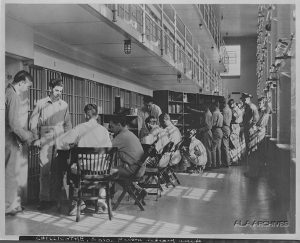
From Record Series 18/1/57, Folder: “Prison Libraries, 1936-1957”
In the mid-1930s, the American Library Association formed a Committee on the Libraries of the American Prison Association. Found in Record Series 23/40/5, this collection contains the Committee’s surveys[1] from 1936-38 of prison libraries across the nation; reports on prison librarianship which include historical information on recommended book titles and magazine subscriptions, cataloging, circulation protocols, staffing, readership habits, and testimony from prisoners; correspondence[2] of librarians, prison administrators, and prisoners; and a selection of prison newsletters and newspaper clippings.
One of the most touching aspects of this collection are the letters and poems by prisoners who benefited from the library and literacy services during their incarceration. To many prisoners, the library service was their first real experience with reading. In their letters, inmates often expressed looking forward to their weekly visit and the materials they checked out would enthusiastically be circulated throughout their ward. One librarian, Dorothy Randolph[3], described a growing popularity of her story hour and of preparing scrapbooks of magazine clippings and pictures for the least literate of the population. Librarian Hilda Hinckley published an article, “Pegasus in Prison” (1937), detailing her work with the inmates in a women’s penitentiary and the poems they produced in the poetry club.
“The Seed” was a booklet of poetry produced by the inmates in Framingham, Massachusetts. The archives has booklets from 1934 and 1935. These beautiful poems express snapshots of daily life in prison, reminiscences of the past, and a range of emotions from despair to hope, such as the following poem:
Hopeless hopes and fears
Another day is ended,
Another night is here,
Now you rest your weary heads
Of hopeless hopes and fears.You dream of walls and prison bars
As you toss the whole night through,
And wonder if your star is still guiding you.You’re restless all night long,
You lie and think of certain things,
With your shattered hopes and fears,
Wondering what the morrow brings.Then the morning light arrives,
You’re thankful for another day.
Again you begin to realize,
“Haven’t I done enough to pay?”— by M. Eagan, printed in “The Seed,” 1935[4]
The goals of library service to prisoners are passionately stated by R. Lindquist, Chairman of the Committee on Institution Libraries in a 1937 letter:
“[W]e want people over the country to know that it is worthwhile to attempt rehabilitative work in prisons; we want to help them think of prisoners as fellow human beings; we want them to help the prisoner to a constructive way of living, by providing the facilities which will help make it possible for him to find a legitimate place in life for himself. We are convinced that a good library service is one very tangible thing that can be provided to help further this work. Books can bring relief from the deadening effects of the routine of institutional life. We believe that they can do much to keep personality intact, and stimulate an active interest in life. A good library service goes further; it opens new fields, arouses new interests, and suggests new motives for living. It can do much to right warped social viewpoints. It can teach; it can provide knowledge. Vocational training and self-improvement, no matter whatever it be the study of Better English or even of etiquette, find their roots in books.”[5]
Citations:
[1] Survey Response: South Dakota Training School, Plankington, SD, Institutional Libraries Committee Publications, 1930-1938, Record Series 23/40/3, Box 2, Folder: Survey 1936-1939, American Library Association Archives.
[2] F. J. Rowan to John Chancellor, August 10, 1935, Institutional Libraries Committee Publications, 1930-1938, Record Series 23/40/3, Box 2, Folder: Survey 1936-1939, American Library Association Archives.
[3] Dorothy Randolph to Miss Jones, missing page 2, circa 1935, Institutional Libraries Committee Publications, 1930-1938, Record Series 23/40/3, Box 2, Folder: Survey 1936-1939, American Library Association Archives.
[4] M. Eagan, “Hopeless hopes and fears,” The Seed, 1935, Institutional Libraries Committee Publications, 1930-1938, Record Series 23/40/3, Box 2, Folder: Inmates’ Letters and Writings, American Library Association Archives.
[5] R. Lindquist to Joseph Russel, April 17, 1937, Institutional Libraries Committee Publications, 1930-1938, Record Series 23/40/3, Box 2, Folder: Inmates’ Letters and Writings, American Library Association Archives.
For more information:
Institutional Libraries Committee Publications, 1930-1938, Record Series 23/40/3
Institutional Libraries Committee Correspondence, 1934-1948, Record Series 23/40/5
ALA Statement on a Prisoner’s Right to Read